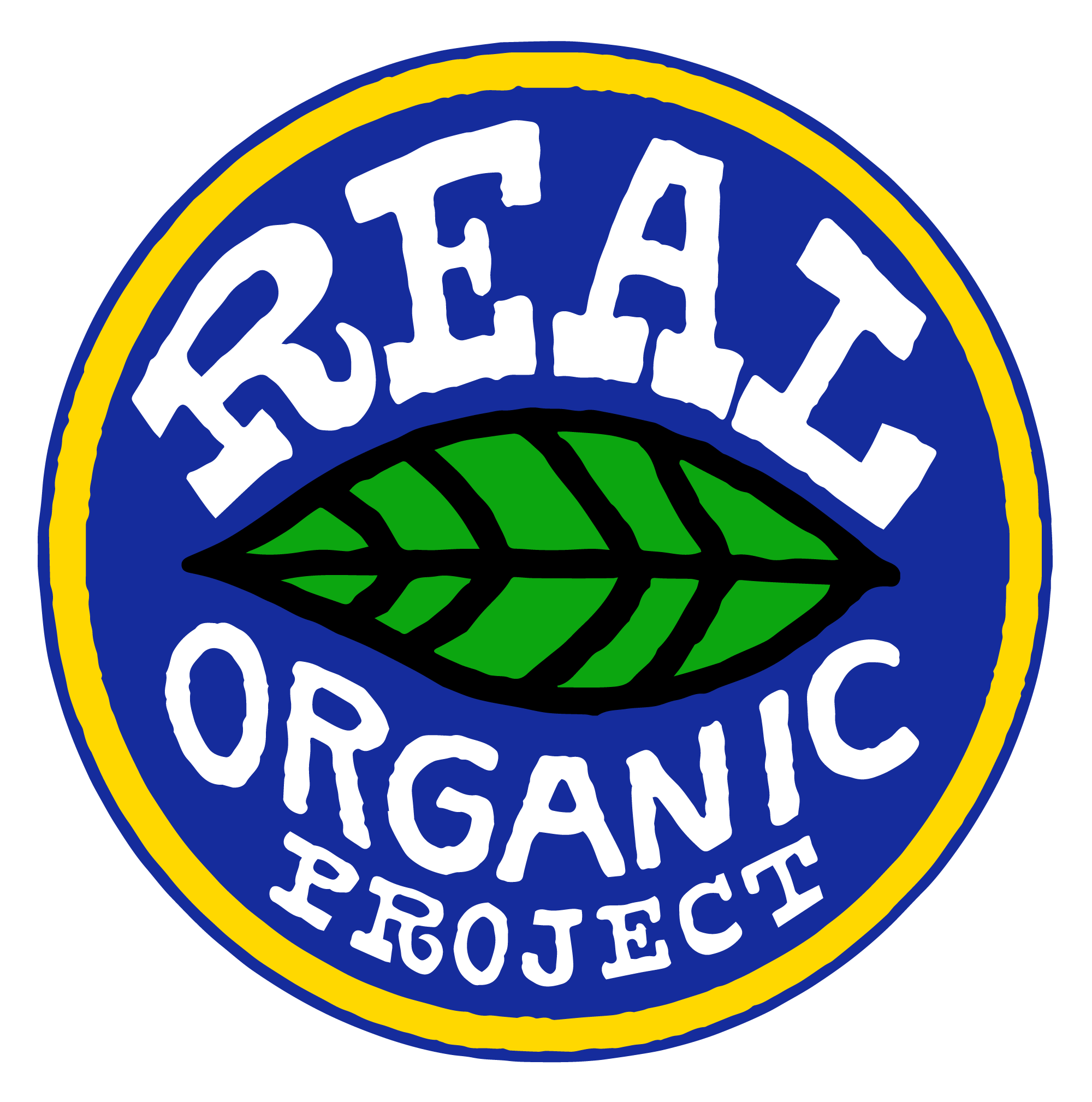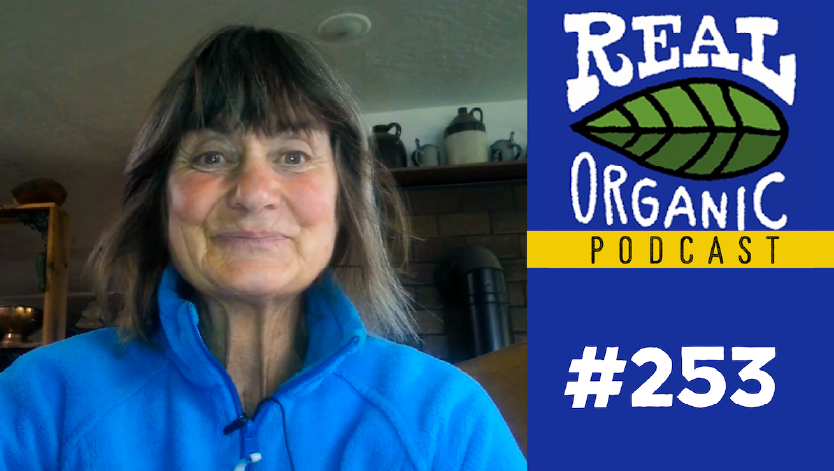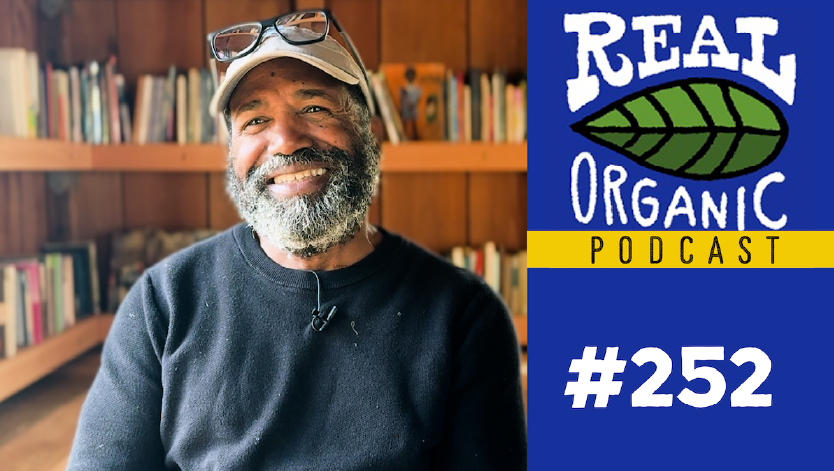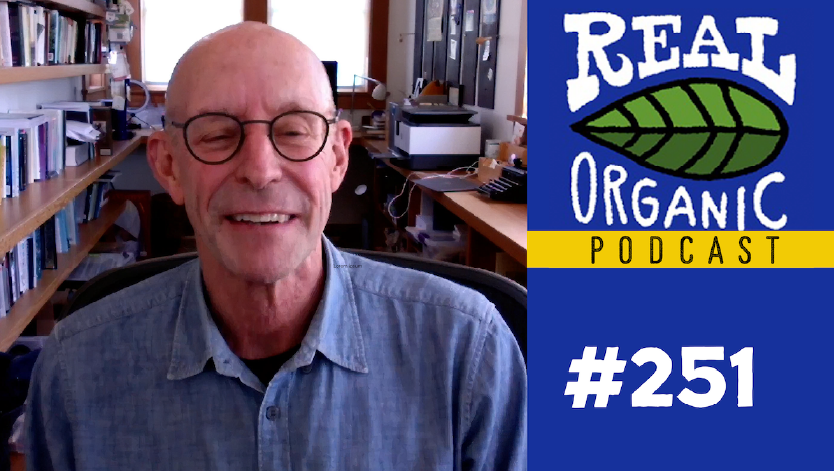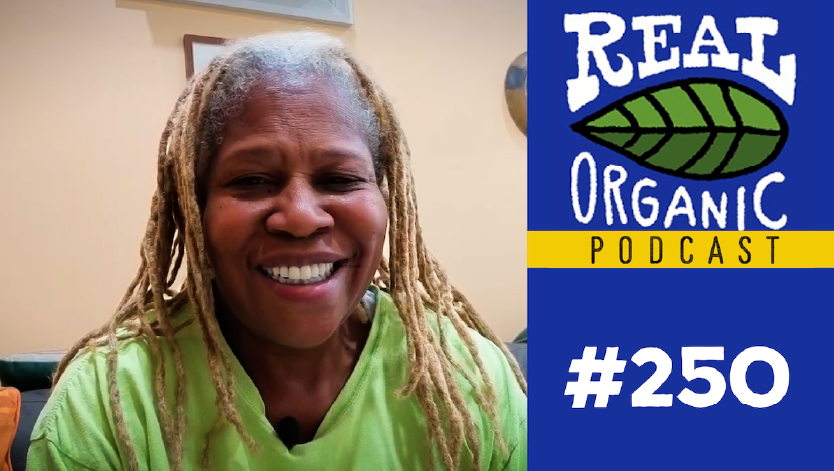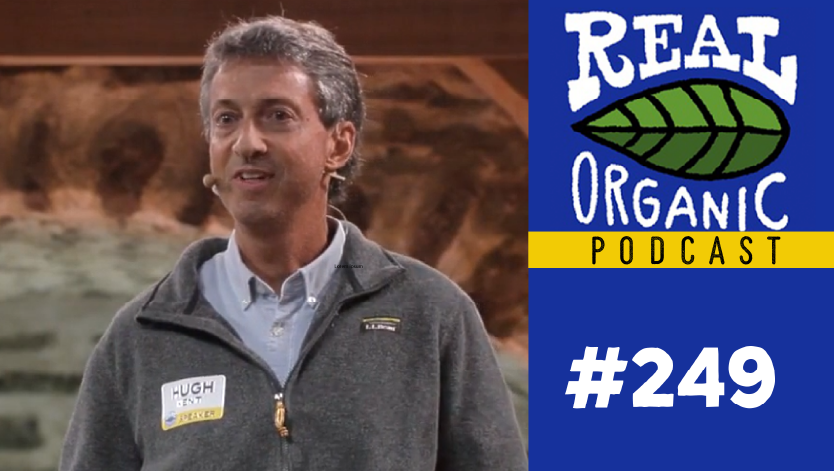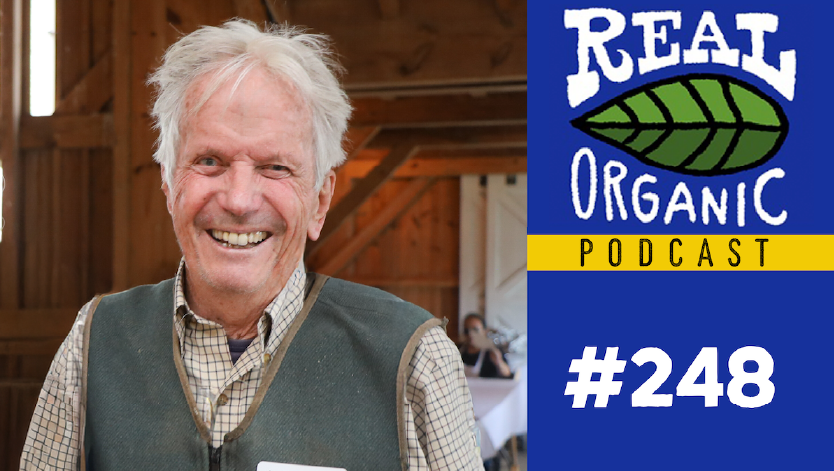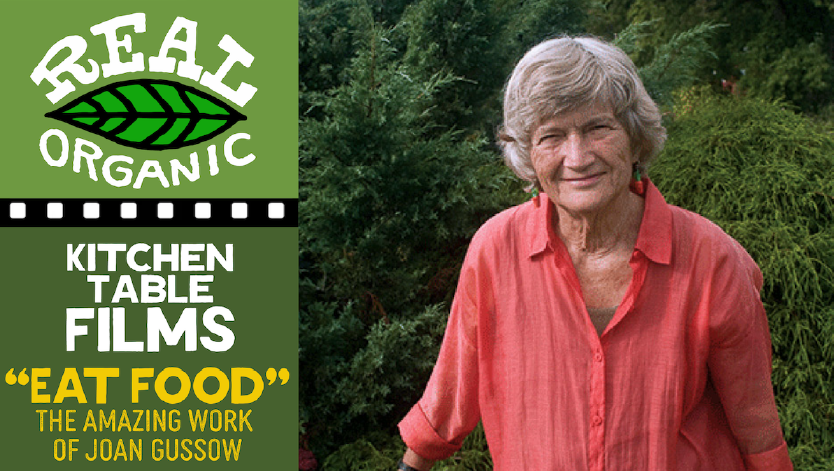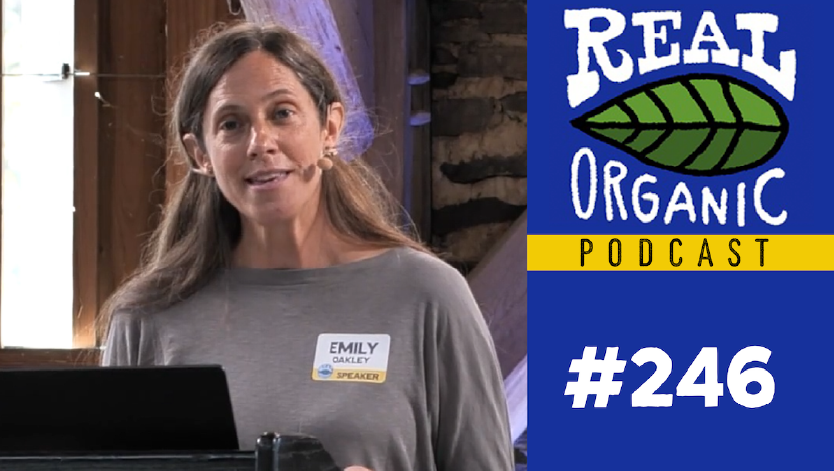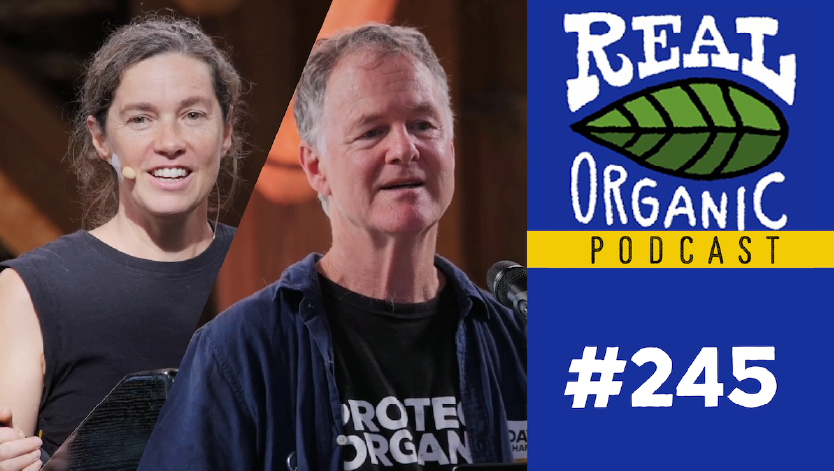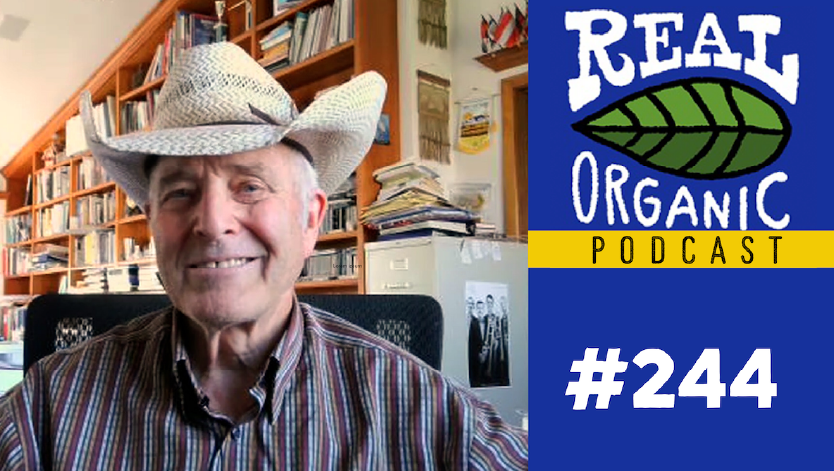Episode #231
The Real Story Of Whole Grain Bread with Michael Pollan + Dan Barber
Whole grain bread may seem like a simple food, but it sits at the center of one of the biggest stories in our food system. In this episode, Michael Pollan, Dan Barber, and other leaders in food and agriculture unpack the journey of grain – from field to mill to table – and what gets lost when we trade nutrition for shelf life. These voices make the case for real bread made with soil-grown, nutrient-dense grain that supports not just human health but also regional food systems, crop diversity, and farming with integrity. This is the real story of whole grain bread.
Our Real Story of Whole Grain Bread interview with Dan Barber, Michael Pollan, Bob Klein, Mark Schatzker and Bob Quinn has been edited and condensed for clarity:
You can subscribe and download episodes of our show through your favorite podcast app, our YouTube channel, or stream the audio-only version here:
The Real Story of Whole Grain Bread transcript features snippets from various interviews. Special thanks to Bob Klein and Community Grains for allowing us to publish footage from their panel with Michael Pollan.
Dave Chapman 0:00
Let me ask you about bread. I have two more questions.
Dan Barber 0:03
I have to bring Eli out here.
Dave Chapman 0:00
I know. I want to talk to Eli. Your bread is astonishingly good. My wife always says, if she knows I’m coming, “Make sure you bring back some bread.” Here’s my question. I asked you before, but I still didn’t get a good enough answer. You didn’t answer.
Dave Chapman 0:28
Your bread is so good. It’s not just that Eli is an awesome baker, which he is. There’s all that technique that goes into it, but there’s also the sourcing and also the milling of the wheat. All of this stuff goes into making… I make good bread. It’s not as good as the bread here. I’m working on it. I’ll get there.
Dan Barber 0:00
You will.
Dave Chapman 0:00
But here’s my question. I don’t mean to pick on Whole Foods, but I’ll just pick them as a place that has an obvious audience that would care about and be willing to pay a premium for your bread. If it was available in every Whole Foods, it would be a major leader for them.
Dave Chapman 0:00
People would go, “Oh my God.” When I said, “What’s the gateway food that would take us to being able to taste again?” Because we’re jaded by too many Doritos – we can’t actually even tell whether that’s a good blueberry. Our taste is so corrupted, which is such a precious sense. I said, “What would the gateway food be?” You said, “Bread.”
Dan Barber 1:40
Did I say that?
Dave Chapman 1:41
You said that.
Dan Barber 1:42
I think I said that partly because of two things. One is that it’s so democratizable. What else built Western civilization? A slice of bread in every person’s mouth that’s truly as nutritious as possible. But the other is that, of all the things we’ve lost the taste of more than anything, it’s wheat. People don’t even understand that wheat has taste. There is a taste.
Dan Barber 2:05
We’ve lost the taste of wheat, which is what a farmer once said to me, and it’s always stuck with me. It’s so true, because we’ve commoditized it and then mummified it. It’s white flour. It’s meant to have no flavor. It’s somewhat like a salad. Romaine and iceberg are mummified to an extent that they’re just a vector for fat and salt – fat dressing or ranch dressing.
Dave Chapman 2:31
Even the whole wheat – if you go get whole wheat flour in the store, it’s not really whole wheat. They’ve taken out the bran.
Dan Barber 2:38
They have taken out the germ and a lot of the bran, too. People say “whole wheat bread.” They throw that around, and it’s usually 20% bran, which is nothing, obviously. Bran is where the flavor is, but you have to be able to deal with it, and you have to have the right varieties. I’ll tell you something – I think genetics with wheat is very important because we’ve been breeding wheat to screen it off.
Dan Barber 3:03
Meaning, we’ve been breeding wheat for white flour. By that, I mean we’ve been breeding wheat that has an exterior, hard bran. We want hard brans because hard brans crack easier in the milling process and give you white flour faster and cleaner. That’s very expensive for all the powers in the milling industry. It always has been.
Dan Barber 3:23
But you create wheat varieties that crack easily, that give you the endosperm. That’s a huge money difference for the millers. That hard wheat is very unpalatable. The softer spring wheats – dark wheat, softer brans – are where the heirlooms are going to be. Einkorn is a good example, or emmers – those are much softer. But that’s before we were selecting for white flour. We were whole grains.
Dan Barber 3:52
We were still trying to screen it off. I just had a talk with all my cooks and the waiters. I was like, “For the diners who come in here and say, ‘I’m so happy to finally have bread that my great-grandparents used to have’ – it’s like, your grandparents didn’t have this. Your grandparents were trying to make white flour too. Your great-grandparents were…”
Dan Barber 4:14
You know what? We’ve been trying to make white flour since Roman times. Everyone’s been screening it off with bedsheets. Since the beginning of time, we have chased the sweet, energy-dense white flour.
Bob Klein 4:25
Morning.
Dave Chapman 4:26
Good morning. Welcome to the Real Organic Podcast. I’m very pleased to be talking with Bob Klein this morning. Bob is co-owner, with his wife, Maggie, of Oliveto in Oakland, California. He also has a brainchild called Community Grains. Tell me a little bit about Community Grains. What’s your vision for that?
Bob Klein 4:52
Creating a thriving alternative grain system at scale – being able to go to the grocery store and buy bread that isn’t garbage, that actually has nutrients and tastes great, and not spend $15 for it. Grain is interesting in that it’s scalable. It’s hard to scale tomatoes, in a way. You can scale tomatoes, but you don’t want those tomatoes. But grain is astonishingly nutritious. People don’t understand how good it is, but it’s the most important food there is.
Bob Klein 5:37
The first industrial food was wheat. In the 1850s, that’s the beginning of our problem. It was much cheaper, had great shelf life, and you could put trainloads… I’ll go to the big roller mill there. There are roller mills that do 4 million pounds a day of flour – truckloads. They’re paid nine cents a pound for the wheat. That’s criminal. End of story. A crime has been committed.
Bob Klein 6:15
So, if you have a farmer who grows good wheat on good soil, and sends a 40,000-pound truckload of good wheat to the grain elevator, they fumigate it, and send it to the mill. The mill takes out 25% of the weight – so that’s 30,000 pounds of endosperm, of starch, very little food value. The 25% goes off to a feedlot, or to feed chickens. They can make more money in that way.
Bob Klein 6:58
Some of it goes to vitamin E. Now you’ve got 30,000 pounds of nothing. Then it goes to the bread factory, and the wheat is high protein. Well, it’s probably not high protein because it’s good wheat. Bad wheat is usually high protein because the soil has been destroyed with the protein. I’m going to change where the farm came from.
Bob Klein 7:28
Now we’ve got bad wheat going in. You lose 25% of it. Now you have nothing. But it’s high protein because it’s been nitrogened to death. Then you go to the factory, and then they can put it in a bag within three hours. Then we’re outraged that they’re using plastic bags.
Bob Klein 8:00
So, this is Michael Pollan. You all know Michael Pollan. He’s just a wonderful journalist and a really smart person, and someone, for me, who continually opens up new ideas and windows. He’s got, I think, some pretty interesting ideas that are coming up.
Michael Pollan 8:23
I thought I would tell a little bit about my own journey and what brought me to this community of people who are semi-obsessed with whole grains and with bread in general. My last book, “Cooked: A Natural History of Transformation,” was the story of four great transformations that we call cooking – one of which is baking. As part of that, I embarked on a quest to make a great loaf of bread – probably a failed quest, but that was the quest.
Michael Pollan 8:54
I started, like most people do, with white bread because that’s most bread in our culture, and it’s easier to do. I got okay at it. But I’ve also written a lot about nutrition, and I knew pretty well that white flour, although it’s incredibly attractive to us for many, many reasons and fits industry in the way mechanization and capitalism work, is not ideal.
Michael Pollan 9:25
One of the subtexts of this book is that for most of human history – and I’m going back two million years – most of the innovations that have happened under the umbrella of food processing, beginning with putting fire to food, continuing with cooking in pots with liquids, and including the various fermented foods, all these incredible inventions of our species have contributed to our health, have tended to make food more nutritious, more interesting, and more flavorful, and have also often increased shelf life.
Michael Pollan 10:10
These were very positive developments. Food processing – a term that now carries negative connotations – was, for most of history, a very good thing for us. It accounts for much of our success as a species, because most animals don’t cook and don’t know how to process their food to make it more nutritious the way we do. There are a couple of exceptions, like squirrels, who bury seeds to ferment them a little.
Michael Pollan 10:33
So, I was really curious to determine the turning point – when food processing went bad. The more I looked at it, the more I realized it was the invention of the roller mill in the 1870s and 1880s. The roller mill is what gave us really white flour. Before that, you could get whitish flour – it tended to be a little yellowish because you were grinding it on a stone mill and then sifting it as finely as you could. You got rid of lots of the bran, but you couldn’t quite get rid of the smushed germ, which, it turned out, was keeping people healthy to a large extent.
Michael Pollan 11:12
But we wanted flour to be whiter. There were a lot of reasons for that. One is prestige – white flour, like white rice, had always carried this kind of prestige. It showed you had money because it took money to sift it. Also, we’re hardwired to like sugar and sweetness. The whiter the flour, the quicker the hit of sugar you get, starting the moment it hits your tongue.
Michael Pollan 11:37
It’s no wonder it became a goal – and it was achieved with these mills that, for the first time it made it possible to break off the bran and germ immediately and leave only the starchy white endosperm as all you were going to eat, which is mostly starch and has some protein as well.
Michael Pollan 11:59
As soon as this innovation hit, many interesting things happened. One was the consolidation of the milling industry. Now that you’re down to white starch, you don’t have the germ that causes rancidity. So, flour could suddenly last indefinitely, which meant you no longer needed a mill in every town. A handful of large companies could now mill all your flour – which is what we now have. You had consolidation of milling, and you also have suddenly a whole lot of health problems.
Michael Pollan 12:33
You have to remember how central bread was in most of European history. It represented about 50% of the calories in the diet for hundreds of years. So, if you fundamentally changed its nutritional quality – which we did – no wonder we had rising rates of chronic disease, nutrient deficiencies, vitamin deficiencies, and people getting sick on this new bread.
Michael Pollan 13:05
Eventually, we figured out part of the problem: we had taken out important nutrients. So, beginning early in the last century, we started fortifying bread. This was the classic capitalist fix. Once you’ve damaged a food, you don’t go back and retrace your steps to get it right – you create a new business that makes money off the problems created by the last business.
Dave Chapman 13:33
I’m talking today with Mark Schatzker. Mark, welcome. Welcome to my home. Welcome to this podcast.
Dave Chapman 13:39
Nice to do it in person.
Dave Chapman 13:41
I will say for our audience that I think that you are one of the really important teachers of our time about food and about the food we eat, what’s wrong, what’s right, and we’ll see where we go from here. We go back to the initial depletion of the raw ingredients being significant in all this.
Dave Chapman 14:07
I think that depletion drives the flavor industry as part of what fuels it. It becomes self-propelling after a while. It doesn’t care. We’re in a system where people are constantly getting the latest flavor of Doritos and the latest Powerade and the latest version… It seems like what you’re describing has set it off and it’s continuing to fuel it. But it seems like a kind of a crazy machine that is running amok.
Mark Schatzker 14:45
Yeah, it is. It’s, it’s sort of a self-fueling thing. Although not in certain cultures.
Dave Chapman 14:52
Okay. That’s a question. Is this about culture?
Mark Schatzker 14:56
It’s difficult to say. Everyone says, “Oh, it sounds like that’s a culture thing.” Well, if it is a culture thing, then all we should be doing is talking about culture. I think it goes deeper than that. I got really interested in this question of Italy. I wanted to know what is it that’s different about Italy compared to us.
Mark Schatzker 14:56
I started to look back in the history books, and what I found actually surprised me. I found out that there was a time in Italy – northern Italy in particular – when it wasn’t actually different from us. It was actually the same. This is going back a little more than a century. They had an epidemic of something called pellagra, which is an Italian word in a local dialect. It means “rough skin.”
Mark Schatzker 15:20
It was this mysterious disease. One of the first people to notice it was the famous German writer Goethe. He noticed it when he was doing this kind of tour of Italy. It would start in the spring, and it would be like these strange skin scales. Then it might go away, but it would come back the next spring, and it might be worse. It would get worse and worse. People would get diarrhea and delirium. They attacked children, they did all sorts of bizarre things, and eventually, it would lead to death.
Mark Schatzker 16:01
Pellagra mysteriously crossed the pond and showed up – I think it was in Georgia first – and it started to spread across the South. The South became the Pellagra Belt. It was very much like the obesity epidemic, insofar as it was an epidemic and no one knew what was causing it.
Mark Schatzker 16:17
There were all sorts of strange theories. Some people thought it had to do with moisture. They said, if you lived too close to a river or too far from a river, you could get pellagra, but if you lived just the right distance, you didn’t. For some reason, divorced men would get pellagra, but married men didn’t. Jews didn’t seem to get pellagra. Some people thought it was mosquitoes. Some people said it was sandflies.
Mark Schatzker 16:36
There were a hundred different theories. Nobody knew what it was – until this guy, an epidemiologist named Joseph Goldberger, was sent down to a sanatorium. They thought he was nuts because he said, “Don’t touch a thing.” He said, “Don’t clean the rooms. Don’t do any more extra laundry.” But he said, “Let’s feed them differently.” He said, “Let’s give the inmates things like peas, milk, cheese, and maybe meat, if they could afford it.” The pellagra went away.
Mark Schatzker 17:00
That was one of the most important findings in what would become the science of nutrition, because they realized that there was some essential element in food that caused this disease. If this element wasn’t there in a sufficient quantity, you got this strange disease. That element is what we now call niacin, vitamin B3. That was the beginning of our comprehension of essential nutrients.
Mark Schatzker 17:21
So, the discovery of niacin, and the discovery of this pellagra-preventing diet, really changed nutrition. But what’s so interesting is when you look at how North America dealt with the pellagra problem and how Italy dealt with it. North America married cutting-edge science with public policy. We mandated the fortification of flour. We said, “If people need niacin, let’s add niacin.” They also said, “Let’s add these other B vitamins, riboflavin and thiamine.” They also said, “Let’s throw in some iron for good measure.”
Mark Schatzker 17:44
It started with – I think it was white bread – but then it slowly expanded to things like pasta. Now it’s in pretty much any flour product. Even in corn flour, it’s all enriched. Enrichment and fortification are the same thing. They call it enrichment when the government says you’ve got to do it.
Mark Schatzker 18:08
What’s so funny is Italy didn’t do that. The approach that Italy took – it’s like they were still stuck in the Dark Ages. They said things like, “Well, poor people should raise rabbits,” because rabbits are an economical form of meat. And, “We should have communal bread ovens.” And, “Oh, maybe people with pellagra should drink wine.”
Mark Schatzker 18:29
You just think, “Are you guys idiots?” Funnily enough, it actually wasn’t bad advice. Because back then, the wines weren’t very well filtered. They had all sorts of yeast in them, and yeast is an amazing source of niacin. What’s even more interesting is that it actually worked. It didn’t work as quickly, but Italy literally ate its way out of a nutritional deficiency.
Mark Schatzker 18:47
Now here’s where things get more interesting. Fast forward the clock a hundred years. What was the Pellagra Belt has become the Obesity Belt. It’s become the Diabetes Belt. You look at Italy, and what was the Pellagra Belt is now northern Italy – arguably the most economically productive part of Europe, even more productive than the Rhine Valley.
Mark Schatzker 19:06
Northern Italy has got serious amounts of money. I just don’t want to create the sense that it’s a bunch of rich people. It’s an incredibly functional, beautiful society. It’s where they design their beautiful sports cars and where the fashion comes from. They really have lifestyle nailed down. The architecture is beautiful. The food’s great. Northern Italy is an amazing place to live, and they have this wonderful relationship with food.
Mark Schatzker 19:27
Meanwhile, what the heck happened in the American South? You’d think that this exacting science of nutrition would have fixed the problem. On the surface, it sort of looks like it made it worse. Now, what I find so interesting about this approach is the assumptions behind each one.
Mark Schatzker 19:46
The American approach said, “Okay, there’s something wrong with food, in that sometimes food doesn’t have these nutrients that you need, and there’s something wrong with humans because we don’t know what to eat. We’ll eat this food that makes us sick. So, let’s step in and fix what’s wrong with food.” That’s what we did.
Mark Schatzker 20:01
Italy said, “No, no. There’s nothing wrong with food. The problem is people are too poor to afford food, so let’s give poor people food.” What’s so interesting about the American approach is that this is the approach we kept on taking. Now we fortify breakfast cereals. You can get energy drinks from Starbucks that have twice the amount of riboflavin – I think it is – or niacin, than you actually need. We thought that the cold, precise hand of science could fix everything to do with food.
Mark Schatzker 20:28
If you look at things like plant-based meats, they call it the Impossible Burger because there’s this idea that we can break these bonds of nature and do something almost supernatural – and it doesn’t work. Even the idea that you can flavor a Dorito to taste like a taco – we never questioned it because we just thought flavor was this stupid thing that didn’t make any sense in the first place.
Mark Schatzker 20:50
Whereas over in Italy, they say things like, “Well, you can’t call plant-based milk ‘milk’ because it’s not milk,” or, “Plant-based meat isn’t meat.” We think they have these kind of funny traditional attitudes. Their system works much better than ours because they have a reverence for food – the way it tastes and where it comes from – because they think taste really does matter. And it does matter.
Dave Chapman 21:17
Okay. I am struck by something here. I’m curious what you think about it. The power of how you look at something. We’re talking about two enormously different ways of responding to the same problem, which is a bunch of people who are eating a poor diet because they’re economically disadvantaged. In America, it was, “Let’s add all of these inputs,” which actually sounds a great deal like chemical agriculture to me.
Dave Chapman 21:47
“We have a problem, the land is not thriving, let’s add chemical fertilizers,” and then voilà, we get big green plants. And voilà, I think it leads to a great many problems. In northern Italy, they’re taking the same problem, and they say, “Let’s figure out how we can change people’s access to good food,” which I think is more like saying, “How can we build an organic system so that the land maintains its fertility by improving the cycling of nutrients and water?”
Dave Chapman 22:23
The outcome is we don’t need the pesticides, we haven’t created a whole secondary set of problems. Does that hold up for you?
Mark Schatzker 22:33
Yeah, it does. I don’t know if I thought of it specifically in those terms, but there is a knock-on effect that is directly like that. That has to do with the effects of these vitamins they were adding to food. This is something I got interested in “The Dorito Effect” because I talked about the work of Fred Provenza and the work he would do with goats, where you could make them deficient in a needed nutrient.
Mark Schatzker 23:26
He did phosphorus, and then he’d pair that to a flavoring – something like coconut – so that when the goats became deficient in phosphorus, they would crave the flavor of coconut. So, you pair this flavoring with a vitamin. What I also realized is it could work the other way around. If you start putting vitamins in things, does that start to mess things up?
Mark Schatzker 23:26
I got curious about whether there has been a consequence of this dumping of vitamins into food that we haven’t seen. I know it sounds nuts. We’re into tin-foil-hat territory here because the word “vital” is part of “vitamins.” There’s no calories in vitamins – how could there be anything wrong with vitamins? Vitamins are the nourishing elements of what make food nourishing to begin with. But there is a problem with it.
Mark Schatzker 23:50
The reason we know is because we can look at how animal agriculture changed. I had suspected this for a long time, but I couldn’t find the science. It wasn’t until the algorithms and Google Scholar got good enough that I finally found the body of research, and it comes to us from pig farming. If you look at pig farming in the 1950s, they were doing all sorts of things to try and improve yield, because that’s what the animal scientists have always been trying to do – just get more bang for our buck, so to speak.
Mark Schatzker 24:29
They were doing things like inbreeding pigs for generations to try and get these traits, to grow bigger, faster. Most of it didn’t work. As the science of nutrition came along, it started to change things. What they knew back then was that there was a rocket fuel feed for pigs – it was corn and soy. If you gave them corn and soy, they would grow. They would just take off.
Mark Schatzker 24:29
But they also knew that’s not all you could give them, because if that’s all you gave them, the growth takes off, then it craters. Then they start to lose their hair, they seem to get dizzy, they can’t walk, they get terrible diarrhea – scours – and then die. They were getting something like the pig version of pellagra or a different nutritional deficiency.
Mark Schatzker 24:29
They knew back then that you had to send the pigs out into pasture to balance the diet. They didn’t know why, but everybody pastured pork back then – not because it was trendy, but because you had to, because you couldn’t just feed pigs corn and soy. Then come the B vitamins. There are these amazing trials where they start to take this corn-soy diet and they start to just sprinkle in one B vitamin at a time.
Mark Schatzker 24:29
All of a sudden, we see, instead of cratering, the growth takes off and it keeps going. This changed pig farming. They started to get levels of growth that were unimaginable. They called it optimal. Very quickly, the model of pig farming changed.
Mark Schatzker 24:29
There’s this great document I found – I think it was put out by the University of Illinois in the late 1950s – basically telling farmers, “This is what you do now.” It said things like, “Pigs have a reasonable ability to naturally balance their diet, but we have a better science of it now.” They talked about optimal weight gain.
Mark Schatzker 24:29
So, when we talk about CAFOs and confinement animal agriculture, whether it’s feedlots, or whether it’s chicken houses, or whether it’s these facilities we’ve created for pigs – I don’t even know what to call them; it’s not a barn – I don’t know what it is. They’ve got these factories now in China. None of that would have been possible without the science of micronutrition.
Mark Schatzker 24:29
Vitamins are what made that possible. Because before that, you needed to send your chickens and give them green feed and table scraps or send them outside. Pigs had to be pastured, and cows had to have access to grass. You could give them some grain, but they needed grass.
Mark Schatzker 24:29
Vitamins changed everything. Without the revolution in our understanding of essential nutrients, we would not have confinement animal feeding. It wouldn’t exist. In that regard, it’s very much like what you’re talking about.
Dave Chapman 26:38
That’s a really stunning thing. I don’t think most people understand that. I think people think, “Well, we’ve got confinement livestock now…” Let’s say lots of people think that – they’re not in love with that because the animals lead such a hard life there – but they think that this is the inevitable consequence of increasing efficiency.
Dave Chapman 27:03
But it actually is not about efficiency in terms of the systems. Yes, you can make a very efficient system if you don’t have to pay attention to a whole diet for the animal because you can just hit them with the vitamins.
Mark Schatzker 27:15
Yeah. What’s also interesting is that they have to feed restricted seed stock – the animals that you use to get your eggs, your piglets, or your calves – because they will get morbidly obese. So, this is not really a sustainable diet. But here’s where it gets really scary, because I’m talking about additives we put into animal feed, but we’re putting the same stuff into human feed. If you look at a box of cereal, it’s the same vitamins.
Mark Schatzker 27:39
We talk about the obesity epidemic, and I think one of the things that has so empowered it is the fact that we’ve created the rocket fuel. We’ve taken these empty carbs and put in the B vitamins that are necessary to metabolize those carbs.
Mark Schatzker 27:57
Here’s what’s really interesting about the pellagra diet: it was not this starvation diet of people starving, it was actually an incredibly calorie-rich diet. What did the poor southerners eat? They ate grits, which is cornmeal with molasses and pork fat – carbs, sugar, and fat. They had calories galore, and yet they were starving. Why? We think of calories like energy in the wall. Calories are pure energy. They’re not. Without the necessary micronutrients, the body can’t metabolize those calories.
Mark Schatzker 28:31
I think one of the things that makes Italians skinny is the fact that they’re not getting their B vitamins in their flour – that they have to get it in their leafy greens, for example. Then, when you eat leafy greens, it takes up stomach capacity. It means you’re not eating something calorie-dense. They love those foods.
Mark Schatzker 27:18
They have a whole party in Veneto. They love these members of the chicory family that are so bitter. They have street parties. They love it. You say it’s culture; it is culture. But I think there’s something even more elemental that comes down to nutrition and the relationship with the food that enters your body and how that food is made. How it’s grown, how it’s made, and how it’s altered or not altered.
Dave Chapman 29:12
Just just to be clear…
Mark Schatzker 29:18
Oh, radicchio, by the way. It’s radicchio.
Dave Chapman 29:20
Radicchio. Yeah, right. When the motivation for enriching this rocket fuel for the livestock was that they would grow fast, that they would put on weight fast.
Mark Schatzker 29:33
Yeah. Exactly. The pigs we eat now are bigger, but much younger than the pork we ate.
Dave Chapman 29:43
It would not make them healthier.
Michael Pollan 29:45
I wouldn’t say so, no.
Dave Chapman 29:46
No, they don’t last so long, but they grow very quickly. We’re doing the same thing to our own food, not to mention we’re eating those animals, which are not the same meat as animals that were fed very differently, and we’re enriching the food that we’re getting that is not animal-based with the same kind of rocket fuel. It sounds like we’re creating CAFOs for ourselves.
Mark Schatzker 29:47
Yeah, that’s a good way of looking at it.
Bob Quinn 30:13
We created Wonder Bread, which is really the symbol of this. This was done with government participation, and they fortified the bread and then made it a selling point: “Builds healthy bodies.” It was first eight ways. Now I think it’s twelve ways, and maybe it’s gone higher since then.
Bob Quinn 30:33
So, basically, it’s brilliant business. It allows you to sell the problem and the solution in one neat package, but it’s only as good a fix as our understanding of nutrition is. This is where the work of the man to my left was really central to my understanding. David has done work on food synergy.
Bob Quinn 30:58
One of his, I think, amazing findings – and he’ll tell you more about it – is that, first of all, we know that people who eat lots of whole grain generally are healthier, have less chronic disease, and a better lifespan than other people. We know it has something to do with the nutrients that we took out of whole grain.
Bob Quinn 31:23
But here’s the amazing thing: even people who get all those nutrients from other sources – I’m talking about the vitamins, the fiber, and the oils that are in whole grain – don’t do as well as people who just eat whole grain. It strongly suggests that breaking foods down into their parts and reassembling them doesn’t necessarily work. There could be two possible explanations for that.
Bob Quinn 31:59
One is, we haven’t identified all the stuff we’ve taken out of it. We can only put back what we can measure and return. The other is, as he suggests, that there is some synergy between those nutrients and the structure of the food, which we never talk about. We just talk about these building blocks.
Bob Quinn 32:39
The more I learned about the importance of whole grain – and there was another context in which I was learning about it, which was learning a lot about the gut, which Bob alluded to and Mark can talk to us about in greater detail – but we are learning that our health is not just connected to the foods that we eat in the sense of our bodies. We share our bodies with a vast number of other species of microbes, mostly bacteria, and unless they’re well fed as well, we’re not going to be healthy.
Bob Quinn 32:44
So, all our nutrition science has been built on really feeding our bodies, which really represents only about 10% of the story by species and 1% by number of cells. Unless you take account of the interests of the microbiome – and these are mostly the microbes occupying your large intestine – you are not going to be completely healthy. This brings up the importance of fiber, something that you take out of whole grain to make white bread.
Bob Quinn 32:39
We knew fiber was important, and we had epidemiology suggesting fiber is important, and people thought it had to do with things like bulk and transit time through the digestive system. But lo and behold, the real importance of fiber turns out to be, according to our current knowledge, that it’s the favorite food of the microbes in your gut, and that they need fiber as a food source. Without it, they don’t do very well, and then we don’t do very well.
Bob Quinn 32:39
The complexity of whole grain is such that it’s very interesting to do the reductive science and try to get to the bottom of it. But the important thing to keep your eye on is: we know it’s important. I went looking for my second quest, which was to build a great whole grain loaf. Much, much harder.
Bob Quinn 32:39
So, the question is: why was it so much harder? Why not just substitute white flour with whole grain flour? There’s whole grain flour everywhere. General Mills will sell it to you. But if you simply substitute it in a recipe, it doesn’t work, for a lot of very interesting reasons.
Dave Chapman 34:19
When we were talking earlier, I was struck. You were saying, well, whole wheat, by and large, is almost not ever whole wheat.
Bob Klein 34:27
Yeah. National brand pastas, including Barilla, that say “100% whole grain” on the label – they have the whole grain capsule, “100%,” and they’re testing it at 10.7% germ. So, the amount of germ that you would expect…
Dave Chapman 34:51
There was a 10th of the expected amount, if it were a whole.
Bob Klein 34:57
Yeah. If you follow the USDA, Mayo Clinic, or Harvard, they also recommend three or four portions a day of whole grain. Well, if you’re using pasta, you need 40 portions a day to get that value. The flours were in the 60th decile range – famous, national brand flours. It’s all published with the labels. You can find the complete test on the Community Grains website.
Bob Klein 35:12
Then the question is…well, this is a big mountain. This is really important. We know that whole grains are really important. Everybody concedes there are dozens of studies that present positive outcomes for age-related diseases with whole grain consumption: diabetes, cancers, heart disease, and dementia, and we’re not getting it.
Dave Chapman 36:02
We’re not getting it.
Bob Klein 36:03
I gave a talk at the Culinary Institute of America in Hyde Park. There was a big audience. I mentioned the study, and I said, national brands, we tested national brands, and it was disappointing. I shouldn’t say who, but the president of an important pasta company came up to me. His name was Bob. “So, how’d we do?” I said, “Well, you could improve.” He probably doesn’t know the germ content in his wheat. He probably doesn’t know. He probably would like it to be 100%.
Dave Chapman 36:50
What this says to me is that not only are people not getting whole food, real food, which we know has huge benefits, but it’s literally not available to them. Is that right? Did I get that?
Bob Klein 37:10
The test…obviously ours is 100% whole grain. Bob’s Red Mill tested 100%. King Arthur did not, far from it. Gold Medal, far from it. This whole idea about the value of food being calories or sugar or taste or charming looking farmers, charming looking farmers dogs, children, as opposed to nutrient value is a big part of the problem.
Bob Klein 37:56
To go back to that industry guy who says, “Oh, but look little boy, you don’t understand. You’re just kind of in the stars thinking that you’re going to feed the world without food.” Well, they’re not feeding the world. They’re not giving them anything that they can use, that real nutrition. Calories does not cut it right.
Bob Klein 38:25
Anecdotally, I’ve never seen the study or anything like that. But you put a bunch of white flour and feed rats white flours, they die. white flour, and you feed them whole grain, and they can do okay.
Dave Chapman 38:40
So, in order for people to be healthy and to feel good, they need to be fed nutritious food. yeah. In order to do that…
Bob Klein 38:53
Do you think that’s shocking?
Dave Chapman 38:55
Well, I guess it is shocking. In order to do that, we have to change the food system.
Bob Klein 39:00
Yeah.
Dan Barber 39:00
By the way, if you want to change your diet, increase your health for this, and opt out of the big food chain, I would say that’s the number one place to go – bake your own bread and take control of your own milling. A farmer once told me that the first thing Hitler did when he came to power in 1933, and he started a long list of laws, the first one targeted Jews. They took away the power to mill. They could not own a mill.
Dan Barber 39:36
They couldn’t own a mill in their town or in their region. Mills were closed. Because they knew, he knew, or somebody knew, that was real power. You take that away first, and you become dependent on the state, and you lose control. Taking back control is not just growing your own food, although that’s a great first step. But grains are what feed us.
Dan Barber 40:05
In our culture, taking control of wheat is the change agent. People always ask me, “What’s one thing I could do?” It’s like, “Bake bread,” because you can live on it, and you can do very well on it. Very powerful.
Michael Pollan 40:19
We’ve all had these brick-like hippie loaves that were very common in the late 60s and early 70s. By and large, those loaves sucked because they were substituting not very good whole grain flour for white flour. A couple of things happened.
Michael Pollan 40:40
One is – and we’ll learn this from Steven Jones a little later – we have not been breeding wheat for the purposes of making whole grain flour; we’ve been breeding it to make white flour, to have the biggest, starchiest endosperm and highest protein level in the endosperm possible. When you’re selecting, you can’t select for everything at once. So, if you select for that, you kind of ignore the quality of the bran, the germ, and the flavor of those things.
Michael Pollan 41:08
Over time, bran got harder because that made it easier to mill when you’re making white flour, and bran got more bitter, so it didn’t taste as good as it once did, and as it still could if you kept that in view. There are breeders here working on that, that very question.
Michael Pollan 41:24
Then there’s the issue of commercial yeast. Commercial yeast is adapted to a white flour system. If you don’t have a sourdough starter, and you just use your same recipe and use yeast on whole grain flour, you’re going to have the phenomenon that you’ve all noticed with those hippie loaves, which is it crumbles in your toaster. It doesn’t have any kind of integrity as a loaf of bread because the wheat hasn’t been properly conditioned by a sourdough starter.
Michael Pollan 41:55
So, there’s another change you have to take account of. The recipes themselves, too. Whole grain is much more temperamental. It’s much more active. It has a lot more food for the microbes. So, sometimes your fermentation speeds up and goes crazy.
Michael Pollan 42:09
There are many, many things that have to change. I realized that we’re making whole grain bread in what I call “a white flour industrial complex,” and that is impossible to do well. You need different kinds of wheat, you need different kinds of baking, you need a different microbial culture, and you need a different human culture to make it really well.
Michael Pollan 42:34
I went looking for that, and I had a moment of despair along the way, and I was turning out one lousy loaf after another. I realized, “I don’t just need new flour; I need a whole new civilization to do this right,” which is setting the bar high.
Bob Quinn 42:54
We can’t talk about food independent of health because food and health go together like hand in glove. If you look at the amount that we spend in this country for food plus health, for the last 60 years, it hasn’t really changed much. But what has changed is the ratio of what you’re spending for food and health. It used to be we spent 7 to 9 percent on health and about 18 to 19 percent on food.
Bob Quinn 43:22
Now that’s just reversed. So, the health cost is sky high because so many people are sick, for one thing, of course, and health things cost more. But now 60% of this country has at least one chronic disease. Forty percent have two or more. No country can sustain that, and it’s getting worse and worse year by year. It doesn’t matter what kind of health care program you have.
Bob Quinn 43:47
There’s a lot of debate about that nowadays. It doesn’t matter what kind of health care you have if a significant percent of the people are ill. You’re going to break the country and the system. Eventually, it will come down because no society can pay for that much sickness.
Dave Chapman 44:05
I’m talking today with my friend Bob Quinn. Bob, welcome to my farm.
Bob Quinn 44:10
Great to be here. It’s a gorgeous day, and first time I’ve been here, so it’s been a real treat.
Dave Chapman 44:15
Yeah. Do you believe that the wheat that you grow on your farm now – that the organic wheat grown under that system – is nutritionally superior?
Bob Quinn 44:28
Well, I do. Let me qualify that a little bit. As I mentioned just earlier, a little bit, I didn’t really get into the nutritional aspect of this immediately. With wheat, there was no research about that, for one thing. We ran into a period in the 90s where we started to become the bad boy on the block. Everybody was going wheat-free and gluten-free because nearly 20% of the people in this country could no longer eat what we call modern wheat without difficulty.
Bob Quinn 45:09
We had an ancient grain that I had first seen when I was a kid at a county fair. My father was quite enamored with this because a friend of his had brought this back from Portugal and sent it to a friend of his in our county, and had grown it. It was supposed to come out of a tomb in Egypt. Well, it grew, and so that should have been the first clue. It wasn’t 4,000 years old coming out of tombs because seeds don’t really last that long. It doesn’t matter if they’re in a tomb or not.
Dave Chapman 45:39
They last a long time, but not 4,000 years.
Bob Quinn 45:41
No, not 4,000 years. Anyway, it was a novelty. It was a giant wheat. I always tip my hat now. It was a giant wheat, and the kernels were about two or three times bigger than normal wheat. We took it to this food show, and out of all these hundreds of people who came by – my dad had a little jar, we were showing it to everybody – one person said, “This is just what I’m looking for.”
Bob Quinn 45:55
Because of that one person, we went home. We had 50 pounds or so in storage because another guy had been interested many years before, but then he lost interest before we had enough to give him for his product. So, because of that one person, we planted all 50 pounds on a half acre.
Bob Quinn 46:13
Then, to make a really long story really short, within about 30 years, we were up to 100,000 acres of this stuff. It was scattered around 250 organic farms in Montana, Alberta, and Saskatchewan – most of it being sold into Italy, about 75%, where they make over 3,000 different products. It’s just amazing how it’s taken off. But in the very beginning, we thought of it as a novelty, something unusual – maybe another crop for our rotation.
Bob Quinn 46:57
I had a friend in California who said, “Well, I’ve got an idea for this.” He took it to a pasta manufacturer. They made pasta and made a wonderful whole wheat pasta that had a very nice, smooth texture. Whole wheat pasta in those days was just ground-up modern Durum, and it was very gritty and would scratch the back of your throat. This didn’t do that. It was very soft. It had a soft bran, we found out later, and it just had a nice texture.
Bob Quinn 47:21
My dad gave a package of this to a lady in a nearby town who had such terrible food allergies that she couldn’t eat wheat or many other things. They were completely debilitating her. This was about 1989 or so. I said, “Well, Dad, why did you give her that pasta? You know she can’t eat wheat. It’s going to make her sick.” He said, “Well, it says it’s organic, isn’t it?”
Bob Quinn 47:53
Here my dad is now more converted than I am, you see. Anyway, this lady called back the next day and said, “What is this stuff?” She said when she ate it – and she did a little kinesiology muscle testing to make sure it wouldn’t make her terribly ill – she thought she could try it. So she ate it. She said, “It made me feel better.”
Bob Quinn 48:12
I said, “Wow, I never heard of that before. Well, we’ll give you some more.” Then a few days later, she said, “I have a sister with all kinds of food allergies who can’t eat wheat either. Could we send her some?” I said, “Sure.” We sent her a whole carton full of these little sample bags.
Bob Quinn 48:31
She called us back in two or three weeks after she had eaten this – maybe nearly a month – and she said, “Not only could she eat it and it made her feel better, but she became less sensitive to other foods she was having trouble with.” When I heard that, I said, “Oh, wow. This isn’t just a novelty. This is like a gift from the Lord or something – to help people feel better, to heal.”
Dave Chapman 48:49
This is medicine.
Bob Quinn 48:51
This is medicine. Then my scientific juices started running again. I said, “We need to understand what’s going on with this.” I couldn’t find anybody in America, hardly, in the early ’90s who, first of all, took food allergy or wheat sensitivity seriously. Most of them said, “Well, it’s in their heads. They just believe it’s not good for them, and so it’s a fad.”
Bob Quinn 49:21
But in Italy, I found a group at the University of Bologna and the University of Florence who really did want to look at it. Because in Italy, if you can’t eat your pasta, you don’t just run down the street and buy wheat-free, gluten-free. First of all, it doesn’t exist. But you want to eat your pasta, and you want to know why you can’t. So they were very interested.
Bob Quinn 49:41
They started doing research. It cost us a lot of money, but we ended up with 35 peer-reviewed journal articles published in highly reputable journals, mostly in Europe and U.S. journals, that clearly identified the differences between modern wheat and ancient wheat and how it affected the body. The last dozen or so papers have dealt with chronic disease, and we did human clinical trials.
Bob Quinn 50:18
We don’t know how this works – we don’t know the mode of action – but we know when people eat modern wheat or ancient wheat in a double-blind crossover study – so one group eats one, then the other group eats the other, then they cross over after having a washout period of six or eight weeks – nobody knows what they’re eating. They’re both told it’s going to be good for them because we didn’t want them to think negatively.
Bob Quinn 50:44
But we started studying heart disease, diabetes, irritable bowel syndrome, non-alcoholic fatty liver disease, and fibromyalgia. Those are the main ones that we published. These are all major diseases affecting people throughout the world. We found there was a tremendous difference in how wheat affected these diseases.
Bob Quinn 51:09
What we found was that modern wheat, in every case, was inflammatory at some level, and this ancient wheat was anti-inflammatory. The difference was like 35% to 45% – it was huge. Medicine pills couldn’t mimic that. The researchers were just astounded. They’d never seen anything like this before.
Bob Quinn 51:27
It really started to bring to mind the teaching of Hippocrates from 2,300 years ago, that “food should be your medicine, and medicine should be your food.” It was right in front of me – the very epitome of that. To think that wheat – a food that was a staple for ancient civilizations, particularly in the Western world: the Romans, the Greeks, the Egyptians, the Ethiopians, the Phoenicians, and even parts of China and India – is today forbidden for 20% of the population.
Bob Quinn 52:09
So, what’s happened? A lot of people say, “Well, don’t eat wheat at all.” That’s like throwing the baby out with the bathwater. We need to understand what we’ve done with modern wheat through the breeding programs that focused so much on yield. We’ve so diminished nutrition and brought other problems into effect that now 20% of people have trouble eating it.
Bob Quinn 52:30
So, it does make a difference what seed we put in the ground. The soil is very, very important – it’s the heart. But what we put through that heart, the blood that gets pumped through that heart, really makes a difference – whether it’s good blood or bad blood. The bad blood, in many cases, is a result of the loss of nutrition by focusing too much on just one external or industrial component, whether it’s manufacturing ease, profitability, or higher yields. That’s what we’ve done with wheat.
Dan Barber 53:05
What we’re looking at here – and when you talk to Eli, I think the frame that, to me, is most interesting – is this is actually SpaceX stuff. This is futuristic. This is not what your great-grandparents did. It’s what nobody’s done. We’re charting a new course. To do that, you need to reverse-engineer starting with seed, because seed has been so corrupted with wheat to satisfy white flour, which is 99.999% of the market.
Dan Barber 53:35
I think that’s interesting. There’s a differential here. I think, Crafty, you’re right – Eli and the team are amazing. But there have been amazing bakers here for 20 years. The quality of the wheats that we are growing. By the way, you can have good-quality, soft-bran wheats, but grow them conventionally, but you don’t get the kind of flavors that you get from growing organically.The expression of wheat through the right kind of soil is astounding.
Dan Barber 54:00
When I was researching “The Third Plate: Field Notes on the Future of Food,” I remember reading about old French farmers. They talked about this variety, Ranon, and other varieties that would smell like cinnamon. They said it’s a reward for well-nutrified soil. It was basically soils – they didn’t have nutrients – it was just your soil was well cared for, and you got rewarded with cinnamon.
Dan Barber 54:28
The other day, this incredible farmer from Maryland – who nails it – gave us Ranon, this old French variety. Eli comes running into the kitchen. I hadn’t thought of that cinnamon wheat since 2008, and that’s when I read it, almost 20 years ago. He comes in the kitchen, and he breaks open this thing. Dave, I swear to God, it was cinnamon bread. Like Cinnamon Toast Crunch, but real.
Dan Barber 54:54
It was astounding. I couldn’t believe it. I was like, “This is it. This is what they were talking about.” He said, “The wheat’s gone bad.” That was so interesting. A lot of the cooks said, “Oh, this is corrupted, or whatever.” I was like, “No, guys. What you have in your hand is a gift, and what we need to do is bake this and celebrate it in the dining room. Talk about it, open it up, and let people smell the cinnamon and explain the context.
Dan Barber 55:22
Because it’s the reward for this guy’s soil amendments, rotation, and everything he’s doing right – it’s right here in the flavor.” That still gives me chills talking about it. But we have lost the taste of wheat, and we need to get it back. That has to be done in a local context.
Dan Barber 55:41
Right now, we’re in Tarrytown. That’s a Terre Town. Terre is Wheat Town. This was wheat town. Probably 10,000 varieties up and down the East Coast here are all gone. We need to bring that back. We need to bring it back with intention. It’s not just to grow wheat or any grain locally – which is a good intention – it’s to grow it for the right purpose, which is flavor and nutrition.
Dan Barber 56:05
That requires a certain kind of genetics and a certain kind of soil. It’s all of them coming in. Now you know why wheat built civilizations. Everything I just talked about takes a community to do it. It really is the organic ideal. Everything is connected – the seed, the soil, the community, the baker, and the mill.
Dan Barber 56:24
There’s a tomato – we could go out, pick a tomato, and eat it right now. You don’t need anyone. You need a community – you need ourselves. It doesn’t build community. Community is built through wheat in the West, corn in the Global South, and rice in the East. Those require cooperation and community to make it happen.
Dan Barber 56:44
To me, you’re right. I’m glad I answered that. The most powerful thing could be wheat, and it could be the most democratizable, which is the most exciting part of it. I got to get you a loaf.
